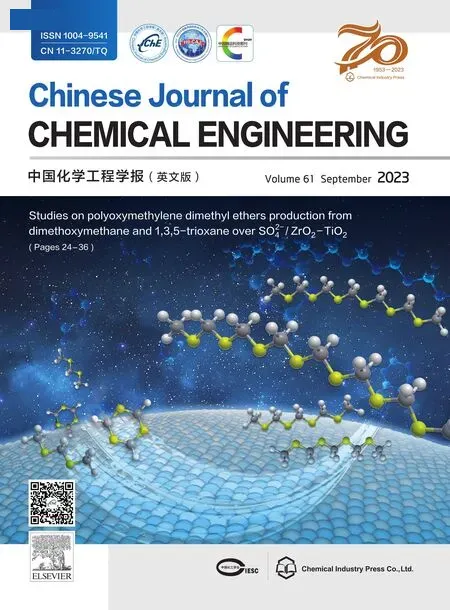
2023年9期
刊物介绍
The Chinese Journal of Chemical Engineering (Bimonthly, started in 1982) is the official journal of the Chemical Industry and Engineering Society of China and published by the Chemical Industry Press. The aim of the journal is to develop the international exchange of scientific and technical information in the field of chemical engineering. It publishes original research papers that cover the major advancements and achievements in chemical engineering in China as well as some articles from overseas contributors. The topics of journal include chemical engineering, chemical technology, biochemical engineering, energy and environmental engineering and other relevant fields. Papers are published on the basis of their relevance to theoretical research, practical application or potential uses in the industry as Research Papers, Research Notes, Chemical Engineering Data and Reviews. Prominent domestic and overseas chemical experts and scholars have been invited to form an International Advisory Board and the Editorial Committee. It enjoys recognition among Chinese academia and industry as a reliable source of information of what is going on in chemical engineering research, both domestic and abroad.
Chinese Journal of Chemical Engineering
- Anti-carbon deposition performance of twinned HZSM-5 encapsulated Ru in the toluene alkylation with methanol
- A highly efficient La-modified ZnAl-LDO catalyst and its performance in the synthesis of dimethyl carbonate from methyl carbamate and methanol
- Studies on polyoxymethylene dimethyl ethers production from dimethoxymethane and 1,3,5-trioxane over /ZrO2-TiO2
- Continuous,efficient and safe synthesis of 1-oxa-2-azaspiro[2.5]octane in a microreaction system
- Closed-loop scheduling optimization strategy based on particle swarm optimization with niche technology and soft sensor method of attributes-applied to gasoline blending process
- Loading CuO on the surface of MgO with low-coordination basic O2- sites for effective enhanced CO2 capture and photothermal synergistic catalytic reduction of CO2 to ethanol
- Extraction and analysis of risk factors from Chinese chemical accident reports
- Enhancing hydrophobicity via core-shell metal organic frameworks for high-humidity flue gas CO2 capture
- Numerical and experimental study on the particle erosion and gas-particle hydrodynamics in an integral multi-jet swirling spout-fluidized bed
- Supercapacitive properties of MnNiSx@Ti3C2Tx MXene positive electrode assisted by functionalized ionic liquid
- A CO2-controllable phase change absorbent solvent used to waste recycling of dining lampblack
- Insights into the adsorption performance and mechanism of Cr(VI) onto porous nanocomposite prepared from gossans and modified coal interface: Steric,energetic,and thermodynamic parameters interpretations
- Role of intrinsic defects on carbon adsorbent for enhanced removal of Hg2+ in aqueous solution
- Direct atomic-level insight into oxygen reduction reaction on size-dependent Pt-based electrocatalysts from density functional theory calculations
- Influence of mineral species on oil-soil interfacial interaction in petroleum-contaminated soils
- Studies on ammonium dinitramide and 3,4-diaminofurazan cocrystal for tuning the hygroscopicity
- Viscosity reduction of tapioca starch by incorporating with molasses hydrocolloids
- Design and manufacture of emulsion liquid membrane based on various amine extractants for separation and extraction of succinic acid from fermentation broth
- Numerical study of the deep removal of R134a from non-condensable gas mixture by cryogenic condensation and de-sublimation
- Boron separation by adsorption and flotation with Mg-Al-LDHs and SDBS from aqueous solution
- Effects of Al and Co doping on the structural stability and high temperature cycling performance of LiNi0.5Mn1.5O4 spinel cathode materials
- Magnetic polyacrylonitrile/ZIF-8/Fe3O4 nanocomposite bead as an efficient iodine adsorbent and antibacterial agent
- Recent advances in preparation of metallic superhydrophobic surface by chemical etching and its applications
- Data-driven intelligent modeling framework for the steam cracking process
- Chemically activated carbon nanofibers for adsorptive removal of bisphenol-A: Batch adsorption and breakthrough curve study
- MXene: From synthesis to environment remediation
